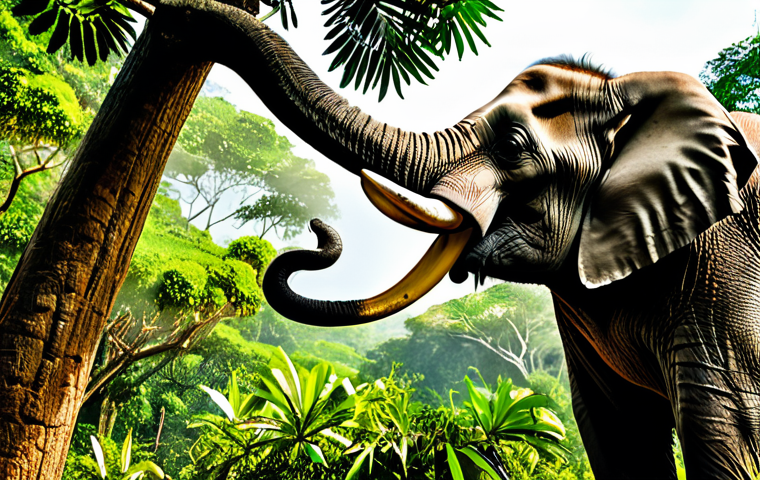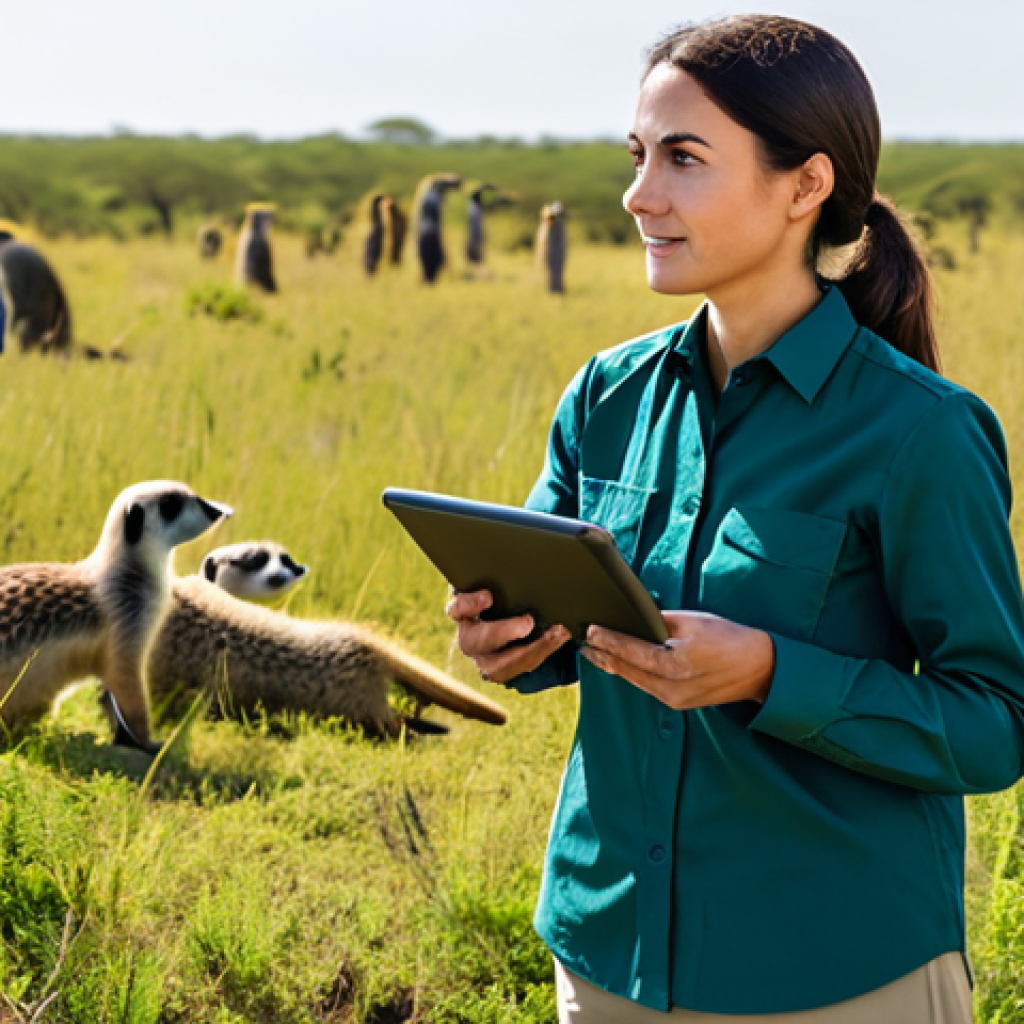Have you ever watched your pet and wondered, ‘Why do they do that?’ That innate curiosity is the very foundation of animal behavior. It’s a fascinating field, now supercharged by AI and advanced tracking, revealing shocking truths about how animals adapt to our changing world and communicate.
From intricate social dynamics to survival instincts, understanding these creatures helps us appreciate their complex lives, and critically, how our actions impact them.
Let’s delve deeper below.
Have you ever watched your pet and wondered, ‘Why do they do that?’ That innate curiosity is the very foundation of animal behavior. It’s a fascinating field, now supercharged by AI and advanced tracking, revealing shocking truths about how animals adapt to our changing world and communicate.
From intricate social dynamics to survival instincts, understanding these creatures helps us appreciate their complex lives, and critically, how our actions impact them.
Let’s delve deeper below.
The Whisper of the Wild: Unraveling Animal Communication Secrets

It’s absolutely astounding how sophisticated animal communication truly is, far beyond simple barks or meows. I mean, think about it – they don’t have our complex spoken language, yet they manage to convey incredibly intricate messages about food, danger, territory, and even emotional states.
When I first started diving into this, I confess, I was skeptical that it could be *that* complex, but observing various species, from the subtle twitch of a deer’s ear warning its fawn, to the elaborate dances of honeybees directing their hive mates to nectar sources, utterly blew my mind.
It’s like discovering a secret world running parallel to ours, where every flick of a tail, every specific chirrup, every particular scent left behind, holds a profound meaning.
This isn’t just instinctual reflex; it’s a dynamic, adaptive system that allows them to survive and thrive. It often makes me wonder if we, as humans, are sometimes too reliant on our words and miss the subtle cues that could tell us so much more about the world around us.
Beyond Vocalizations: The Unseen Dialogues
While we often focus on the sounds animals make – the howls of wolves echoing through the night, the melodic birdsongs at dawn, or the comforting purr of a cat – their communication repertoire extends far, far beyond the auditory.
Visual cues are paramount; think of the vibrant display of a peacock’s tail, a clear signal of fitness and attraction, or the threatening charge of an elephant, a powerful warning to back off.
Scent marking, though often undetectable to our comparatively weak human noses, is a rich and crucial form of long-distance communication, delineating territories, signaling reproductive readiness, and even identifying individuals within a group.
It’s fascinating to consider how a dog “reads” its environment through scent, picking up on stories we can only vaguely imagine. Tactile communication, too, plays a vital role, from the grooming rituals of primates fostering social bonds to the playful nudges and nips exchanged between puppies learning social boundaries.
From my observations, it’s clear that animals leverage every available sense to weave a rich tapestry of messages, creating a communication network that is both efficient and incredibly nuanced.
The Evolution of Animal ‘Language’ and Human Misinterpretations
The evolution of these communication systems is a breathtaking journey, shaped by millions of years of adaptation and natural selection. Each species has developed signals perfectly tailored to its environment and social structure.
What’s often overlooked, however, is how frequently we, as humans, misinterpret or underestimate these communications. We tend to anthropomorphize, projecting our own emotions and intentions onto animals, which can lead to misunderstandings, especially with our pets.
For example, a dog wagging its tail isn’t always a sign of happiness; a low, slow wag with a stiff body can indicate unease or aggression. My own golden retriever, Buddy, often displays a specific ‘guilty’ look after getting into the trash, but I’ve learned that’s likely a learned response to *my* reaction, not an intrinsic understanding of “guilt” as a human concept.
Understanding these signals from an ethological perspective, rather than a human-centric one, allows us to build stronger, more respectful relationships with animals, truly appreciating their unique ways of expressing themselves.
It requires patience and a willingness to learn *their* language, not just expect them to understand ours.
Survival of the Smartest: Animal Adaptation and Intelligence
It’s easy to assume animals operate purely on instinct, a kind of hardwired programming, but my experiences and observations consistently suggest something far more complex: a profound capacity for learning, problem-solving, and adapting to ever-changing circumstances.
I’ve personally seen squirrels in my backyard figure out increasingly elaborate puzzles to get to birdseed, demonstrating a level of cognitive flexibility that goes well beyond simple trial-and-error.
They remember past failures and adapt their strategies, almost like little furry engineers. This isn’t just about survival; it’s about optimizing their chances, and often, it’s thrilling to watch unfold.
The sheer ingenuity displayed by various species in navigating their environments, finding food, avoiding predators, and securing mates speaks volumes about their inherent intelligence, a form of intelligence that, while different from ours, is no less valid or effective.
We often forget that what seems like ‘simple’ animal behavior is often the culmination of complex cognitive processes honed over eons.
Navigating a Changing World: Behavioral Flexibility in Animals
The world is constantly shifting, and animals, far more than we give them credit for, exhibit an astonishing degree of behavioral flexibility. This isn’t just about evolving over generations; it’s about individual animals altering their behavior in real-time to cope with new challenges.
Consider urban foxes, adapting their hunting schedules to nocturnal hours to avoid human interaction, or even learning to navigate complex road systems.
I’ve witnessed pigeons in city parks learning to use pedestrian crosswalks, truly! It’s an incredible testament to their capacity for learning from observation and adapting to novel stimuli.
This flexibility is crucial for their survival, especially as human expansion encroaches on their natural habitats, forcing them to find new food sources, build different kinds of shelters, and develop innovative ways to coexist (or avoid) us.
It truly underscores how dynamic and responsive animal minds are, not just static biological machines.
Problem-Solving Prowess: When Instinct Isn’t Enough
When basic instincts aren’t sufficient to overcome an obstacle, that’s when animal intelligence truly shines. There are countless examples of animals using tools, engaging in strategic hunting, and even showing evidence of forethought.
I vividly recall watching a crow in a documentary bending a piece of wire into a hook to retrieve food from a tube, a clear demonstration of insightful problem-solving that made my jaw drop.
Orcas have been observed coordinating complex hunting strategies, herding prey with waves, and even passing down these techniques through generations – a form of cultural transmission.
Dolphins using sponges as nose protection while foraging on the seafloor is another classic example of tool use. These aren’t isolated incidents; they’re patterns observed across diverse species, indicating that animals possess a genuine capacity for cognitive processes that allow them to analyze situations, devise solutions, and even anticipate outcomes.
It forces us to re-evaluate our long-held assumptions about where the line between “instinct” and “intelligence” truly lies.
The Intricate Web: Social Structures and Kinship in the Animal Kingdom
Human society often prides itself on its complex social structures, but if you spend any time observing animals, you quickly realize they’re masters of intricate social dynamics themselves.
From cooperative hunting and shared child-rearing to elaborate dominance hierarchies and surprisingly strong bonds of friendship and family, the animal kingdom is brimming with fascinating examples of social organization.
I’ve been particularly moved by stories of elephants mourning their dead, or chimpanzees forming lifelong friendships, demonstrating emotional depths that resonate deeply with our own experiences.
It makes you realize that perhaps our need for connection and community isn’t so uniquely human after all. These social bonds aren’t just about feeling good; they’re absolutely essential for survival, providing safety in numbers, enhancing foraging efficiency, and ensuring the propagation of the species.
Cooperation and Altruism: More Than Just Self-Interest
One of the most compelling aspects of animal behavior for me is the undeniable evidence of cooperation and even altruism. While Darwinian evolution emphasizes individual survival, countless examples show animals working together, often for the benefit of the group, sometimes even at a perceived cost to themselves.
Consider meerkats taking turns as sentinels, standing guard while others forage, or vampire bats sharing blood meals with hungry roostmates who failed to find food themselves.
These behaviors aren’t random; they’re often driven by kin selection (helping relatives ensures shared genes survive) or reciprocal altruism (I help you now, you help me later).
From what I’ve observed in various wildlife documentaries and even in my own garden (watching a group of sparrows mob a much larger bird of prey), these acts of collective action are incredibly powerful.
They reveal a nuanced understanding within animal groups that ‘we’ often do better than ‘I’ alone, challenging the simplistic view of nature as purely “red in tooth and claw.”
Dominance and Hierarchy: Maintaining Order in Animal Societies
Just like in human societies, animal groups often have clear social hierarchies, from the pecking order in a chicken coop to the complex alpha male/female dynamics in wolf packs.
These hierarchies, while sometimes established through aggressive displays, often serve a vital purpose in maintaining order, reducing conflict, and ensuring efficient resource distribution within the group.
A stable hierarchy means less energy is wasted on constant fighting, allowing the group to focus on finding food, raising young, and defending against threats.
I’ve often seen how a clearly established hierarchy can lead to a surprisingly peaceful coexistence within a group, as each individual knows its place and acts accordingly.
It’s not about constant bullying, but often about subtle cues and established behaviors that maintain the social fabric. Understanding these dynamics is crucial, especially when trying to manage or conserve animal populations, as disrupting these natural structures can have cascading negative effects on the group’s overall well-being.
The Human Footprint: Our Profound Impact on Animal Behavior
It’s impossible to discuss animal behavior in today’s world without addressing the elephant in the room: our own presence. From urbanization and habitat destruction to climate change and direct interaction, human activities are profoundly reshaping how animals live, adapt, and behave.
And honestly, it’s a double-edged sword. While our advancements bring us closer to understanding them, our sheer numbers and resource consumption are forcing animals into incredibly difficult choices.
I’ve witnessed firsthand how wildlife near my suburban home has altered its foraging patterns, becoming more nocturnal or even learning to utilize discarded human food, which, while an adaptation, isn’t always for the better.
This isn’t just about majestic lions or polar bears; it’s about the everyday creatures adapting to our every move, often silently, under immense pressure.
It truly makes you stop and think about the responsibility we carry.
Adapting to Anthropogenic Landscapes: Urban Wildlife
The rise of urban wildlife is a compelling, if sometimes concerning, example of animals adapting to landscapes shaped entirely by humans. Raccoons raiding trash cans, coyotes hunting in city parks, and even peregrine falcons nesting on skyscrapers – these animals are demonstrating extraordinary behavioral plasticity.
They learn to navigate concrete jungles, exploit new food sources (often human-derived), and alter their daily rhythms to avoid or utilize human presence.
From my perspective, this behavioral shift is a direct consequence of habitat fragmentation, forcing animals to either adapt or perish. It’s a testament to their resilience, but also a stark reminder of how much we’ve altered their natural world.
We’re seeing changes in vocalizations to cut through urban noise, shifts in migratory patterns, and even changes in diet. It’s a live experiment in evolution, happening right outside our windows, driven by our ever-expanding cities.
Conservation Challenges: When Behavior Becomes a Barrier
Sometimes, the very behavioral traits that helped a species thrive in its natural environment become a liability when faced with human-induced changes.
For example, species with very specific habitat requirements or highly specialized diets struggle immensely when those resources are destroyed or altered.
Or consider animals that are naturally fearful of humans; while this is a survival trait, it can hinder conservation efforts like rehabilitation or relocation.
Conversely, animals that habituate too easily to human presence can become “nuisance” animals, leading to conflict. This is a complex dance where understanding animal behavior is not just academic; it’s critical for effective conservation strategies.
We need to consider how our interventions might unintentionally disrupt their natural behaviors and social structures, making species even more vulnerable.
It’s a delicate balance, and often, the solutions are far from simple, requiring deep empathy and scientific insight.
| Behavior | Primary Function | Example Species | Observation Note |
|---|---|---|---|
| Territorial Marking | Delineating boundaries, advertising presence, preventing conflict. | Dogs, Bears, Many Bird Species | Often involves scent, visual displays, or vocalizations. My neighbor’s dog always marks the same trees! |
| Courtship Displays | Attracting mates, assessing fitness, synchronizing reproduction. | Peacocks, Birds of Paradise, Spiders | Can be highly elaborate, involving dances, songs, or physical adornments. Truly captivating to witness in nature. |
| Foraging | Locating, acquiring, and consuming food resources. | Squirrels, Wolves, Whales | Varies greatly by species; can be solitary or cooperative. Those clever squirrels never give up on my bird feeder. |
| Grooming (Allogrooming) | Hygiene, social bonding, stress reduction, parasite removal. | Monkeys, Cats, Birds | An incredibly important social behavior that reinforces group cohesion. I love watching my cats groom each other. |
| Play Behavior | Learning social rules, developing motor skills, practicing hunting techniques, strengthening bonds. | Puppies, Kittens, Otters, Primates | Often mimics adult behaviors but without serious intent. My dog loves to “hunt” his toys with exaggerated moves. |
Leveraging Technology: AI and Tracking in Behavioral Science
The advent of advanced technologies like AI, sophisticated tracking devices, and drone imagery has absolutely revolutionized the field of animal behavior.
We’re moving beyond simple observation to truly data-driven insights, uncovering patterns and complexities that were previously impossible to detect. Honestly, it feels like we’ve been given a superpower, allowing us to ‘listen in’ on animal conversations and track their movements with unprecedented precision.
This isn’t just about cool gadgets; it’s about pushing the boundaries of what we can learn and accelerating our understanding of the natural world. From analyzing vast datasets of animal vocalizations to predicting migration routes with uncanny accuracy, technology is opening up new frontiers, offering us a window into lives we once could only guess at.
It’s a thrilling time to be interested in animal behavior.
AI’s Role in Decoding Complex Animal Data
Artificial intelligence is a game-changer when it comes to processing the immense amounts of data we collect on animal behavior. Think about it: hundreds of hours of video footage from remote cameras, millions of data points from GPS trackers, or vast libraries of animal calls.
Manually analyzing all that is simply impossible. AI algorithms, however, can identify individual animals from their unique markings, detect specific behaviors from video, or even differentiate between subtle variations in vocalizations that signal different meanings.
I’ve been following projects where AI is being used to recognize individual whales by their fluke patterns, or track the precise movements of entire insect swarms.
This isn’t just about speed; it’s about finding hidden correlations and patterns that would be invisible to the human eye, offering deeper insights into social structures, foraging strategies, and even early warnings of disease outbreaks.
It’s allowing us to move from anecdotal observations to truly evidence-based understanding.
The Power of Advanced Tracking and Bio-logging
Modern tracking technology, from miniature GPS tags to bio-logging devices that measure heart rate and energy expenditure, is giving us an intimate look into the lives of animals in their natural habitats without disturbing them.
I remember reading about a project where scientists attached tiny loggers to puffins, revealing their incredible deep-sea dives for food, something previously unknown.
These devices can transmit real-time data on migration routes, preferred foraging grounds, and even how much energy an animal expends during different activities.
This level of detail is invaluable for conservation efforts, allowing us to identify critical habitats, understand the impact of human activities, and design more effective protected areas.
The ability to track individuals over their entire lifespan, or to monitor entire populations from space, provides an unprecedented macro and micro view of animal life, pushing the boundaries of what we thought was possible in behavioral ecology.
Beyond Pets: The Ethics of Human-Animal Interaction
When we talk about understanding animal behavior, it invariably leads us to a crucial, often uncomfortable, conversation: our ethical responsibilities towards them.
It’s not just about what animals *do*, but about how our actions influence their lives, both positively and negatively. I often reflect on the deep bonds we form with our pets, but also the broader implications of our interactions with wildlife, in zoos, in research, and in the wild.
It strikes me that true respect for animals means not just appreciating their complexities but also striving to minimize our harm and maximize their well-being.
This isn’t a simple task, and it involves continuous learning and critical self-reflection. My own journey into animal behavior has certainly made me more conscious of my own impact, from the products I buy to how I interact with the wildlife around my home.
Ethical Dilemmas in Behavioral Research and Conservation
As we gain more sophisticated tools to study animal behavior, new ethical dilemmas inevitably arise. How much intrusion is acceptable when tagging an endangered species?
When does observation become harassment? These are questions researchers grapple with constantly. There’s a fine line between gaining critical knowledge to protect a species and causing undue stress or altering natural behaviors.
In conservation, the ethics are equally complex: is it right to relocate a “problem” animal, even if it saves its life, given the stress and potential disruption to its social structure?
Should we interfere with natural predator-prey dynamics to save a vulnerable population? These aren’t easy answers. From my own engagement with conservation discussions, I’ve learned that every decision is a balancing act, requiring careful consideration of animal welfare alongside broader ecological goals.
It’s a constant reminder that with great knowledge comes great responsibility.
Fostering Coexistence: A Call for Empathetic Understanding
Ultimately, understanding animal behavior isn’t just an academic pursuit; it’s a pathway to fostering better coexistence between humans and the natural world.
If we can truly grasp why animals do what they do – their motivations, their needs, their communication styles – we are far better equipped to avoid conflict, design sustainable urban environments, and protect species.
This means educating ourselves, teaching children to respect wildlife, and advocating for policies that prioritize animal welfare and habitat preservation.
It means moving beyond a purely human-centric view of the planet and embracing our role as just one species among many. I believe that by engaging with the science of animal behavior, we can cultivate a deeper empathy, leading to more thoughtful actions.
It’s about recognizing that animals aren’t just objects for our study or amusement, but sentient beings with rich, complex lives, deserving of our respect and protection.
Wrapping Up
As we close this journey into the incredible world of animal behavior, it becomes abundantly clear that these creatures are far more complex, intelligent, and emotionally nuanced than we often give them credit for.
From their sophisticated communication systems and astonishing adaptability to their intricate social structures, there’s a universe of wonder unfolding right before our eyes.
Our understanding is continually evolving, driven by groundbreaking technology and a growing sense of ethical responsibility. By truly listening to the “whisper of the wild” and recognizing our profound impact, we can forge a path towards genuine coexistence, fostering a future where both humans and animals can thrive.
Useful Resources & Tips
1. Dive Deeper with Documentaries: Programs like BBC’s Planet Earth or National Geographic series offer unparalleled insights into diverse animal behaviors, often showcasing the very latest scientific discoveries and breathtaking footage. They’re a fantastic starting point for visual learners.
2. Responsible Wildlife Observation: If you’re observing animals in your local park or even your backyard, remember to keep a respectful distance. Use binoculars, avoid making loud noises, and never feed wild animals, as this can disrupt their natural foraging behaviors and create dependency.
3. Support Conservation Efforts: Many organizations, both local and international, are dedicated to animal welfare and conservation. Consider volunteering your time, making a donation, or simply educating yourself about their work and sharing it with others.
4. Engage with Citizen Science: Projects like eBird or iNaturalist allow you to contribute your own observations of birds or other wildlife, helping scientists gather vast amounts of data on species distribution, migration patterns, and behavioral changes. It’s a great way to participate!
5. Understand Your Pet’s Body Language: If you have a pet, take the time to learn their specific communication cues. Resources from veterinary associations or reputable animal behaviorists can help you interpret their subtle signals, leading to a stronger bond and fewer misunderstandings.
Key Takeaways
Animal behavior is incredibly diverse and complex, extending far beyond simple instincts to include sophisticated communication, remarkable intelligence, and adaptable problem-solving skills.
Understanding animal communication requires looking beyond vocalizations to visual cues, scent marking, and tactile interactions, which form rich, nuanced dialogues.
Animals demonstrate astonishing behavioral flexibility, adapting to rapidly changing anthropogenic (human-influenced) landscapes, from urban environments to altered habitats.
Social structures in the animal kingdom are intricate, featuring cooperation, altruism, and dominance hierarchies that are crucial for group survival and cohesion.
Advanced technologies like AI and bio-logging are revolutionizing behavioral science, allowing unprecedented insights into animal lives and aiding conservation efforts.
Our human footprint profoundly impacts animal behavior, underscoring the critical ethical responsibility we hold to foster coexistence and protect species through empathetic understanding and informed action.
Frequently Asked Questions (FAQ) 📖
Q: How exactly are these new technologies, like
A: I and advanced tracking, changing what we thought we knew about animal behavior? A1: Oh, it’s a game-changer, truly. I mean, I remember back in the day, if you wanted to track, say, a bear, you’d be hoping your radio collar signals didn’t die or get blocked by terrain, getting just snippets of their movements.
Now, with these incredibly tiny, non-invasive sensors and AI sifting through terabytes of data, we’re seeing things we never could. It’s like peeling back layers you never knew existed.
We’re not just tracking where they go, but how they interact on a micro-level – intricate social networks, subtle communication cues that were just invisible to us before.
I recently read about a study on some deep-sea creatures, where AI analyzed their bioluminescent flashes and revealed these incredibly complex, almost conversational patterns that no human observer could have ever parsed in real-time.
It’s mind-blowing how much more sophisticated their ‘conversations’ are than we ever imagined. Honestly, it makes you feel like we’re finally getting a glimpse into their true world.
Q: Beyond just curiosity, why is understanding animal behavior so crucial for us, especially with our changing world?
A: This is where it gets really real, isn’t it? It’s not just about “isn’t that neat?” anymore. Honestly, it’s becoming a matter of survival, not just for them, but for us too.
When we genuinely understand, say, a specific species’ intricate mating rituals, their unique hunting strategies, or their stress triggers, we can design conservation efforts that actually work, instead of just guessing.
Think about urban wildlife – coyotes in city parks, deer in suburban backyards. We build cities, and these animals adapt. Without understanding their new behavioral adaptations – like how some urban foxes have learned to navigate traffic lights, or the precise timing pigeons in Trafalgar Square use to flock for dropped chips – we’re just blindly reacting.
It’s about designing coexistence. Knowing their movement patterns around human infrastructure, their feeding habits altered by human presence – it’s invaluable.
We’re talking about everything from designing wildlife crossings on highways that animals will actually use, to managing human-wildlife conflict in rural areas.
It really shifts from just ‘observing’ to ‘collaborating’ with nature, even if it’s an unconscious collaboration on their part. It makes you feel a deeper connection, a shared responsibility, you know?
Q: What are some of the most surprising fundamental drivers or instincts that explain why animals behave the way they do?
A: Oh, this is the rabbit hole, isn’t it? The “why” behind the “what.” And often, what seems simple is incredibly complex. For me, one of the most consistently surprising drivers is the sheer plasticity of behavior driven by survival, especially under pressure.
We often think of instinct as rigid, a hardwired program, but I’ve seen countless examples where animals adapt in ways that defy our preconceived notions.
Take cleaner fish. On the surface, they seem to be performing a service, picking parasites off larger fish. But some species will actually ‘cheat’ their clients, taking a bite of healthy tissue if they think they can get away with it!
It’s a complex interplay of hunger, risk assessment, and social dynamics – a behavior that seems ‘bad’ to us but is perfectly rational for their survival in a competitive environment.
Or the incredibly sophisticated ‘deception’ tactics some animals employ. I recently heard about ground squirrels using different tail signals to deceive specific predators – a slow, deliberate wag for coyotes, but a rapid, almost frantic one for rattlesnakes, which also heats up the tail and makes them appear larger on infrared!
It’s not just a reflex; it’s a learned, context-dependent communication strategy. It really shatters the idea that we’re the only ones with complex social rules or problem-solving skills.
They’re just playing a different game, with different stakes, but with an astounding level of ingenuity. And it brings us back to that initial curiosity, doesn’t it?
The more you dig, the more you realize how much more there is to unravel.
📚 References
Wikipedia Encyclopedia
구글 검색 결과
구글 검색 결과
구글 검색 결과
구글 검색 결과
구글 검색 결과






